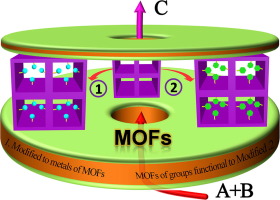Metal–organic frameworks with catalytic centers: From synthesis to catalytic application
Yan-Shang Kang, Yi Lu, Kai Chen, Yue Zhao, Peng Wang, Wei-Yin Sun
Index: 10.1016/j.ccr.2018.02.009
Full Text: HTML
Abstract

Metal-organic frameworks (MOFs), as a new stable class of hybrid materials synthesized, regulated and decorated by rational incorporating organic bridging ligands and metal ions with well-defined coordination geometry have become promising candidates for heterogeneous catalysis in industrial applications. Compared with homogeneous catalysts, MOF catalysts can be easily recycled and reused for several times; while compared with traditional heterogeneous catalysts, they possess tunable size and catalytic centers via exchange or modification of their components. This review will sketch typical successful MOF-catalyzed reactions and summarize various catalytic centers, including the open metal sites, bifunctional acid-base sites in MOFs, as well as catalytic centers introduced to MOFs via PSM. The periodic order and site isolation of the catalytic struts in MOFs eliminate the multimolecular catalyst deactivation pathways to extend the catalytic centers’ functional lifetime and facilitate the studies of their activities and reaction mechanisms. Furthermore, detailed discussion on how the catalytic centers play the roles in the catalytic reactions and how to control the activity and selectivity of them will be given via typical reported examples.
|
Tridentate pyridine–pyrrolide chelate ligands: An under-appr...
2018-03-28 [10.1016/j.ccr.2018.01.012] |
|
Recent advances about metal–organic frameworks in the remova...
2018-03-19 [10.1016/j.ccr.2018.03.015] |
|
Recent advances in ultraviolet and deep-ultraviolet second-o...
2018-03-15 [10.1016/j.ccr.2018.02.017] |
|
Molecular and supramolecular chemistry of mono- and di-selen...
2018-03-15 [10.1016/j.ccr.2018.03.001] |
|
Luminescent oligonuclear metal complexes and the use in orga...
2018-03-13 [10.1016/j.ccr.2018.01.017] |